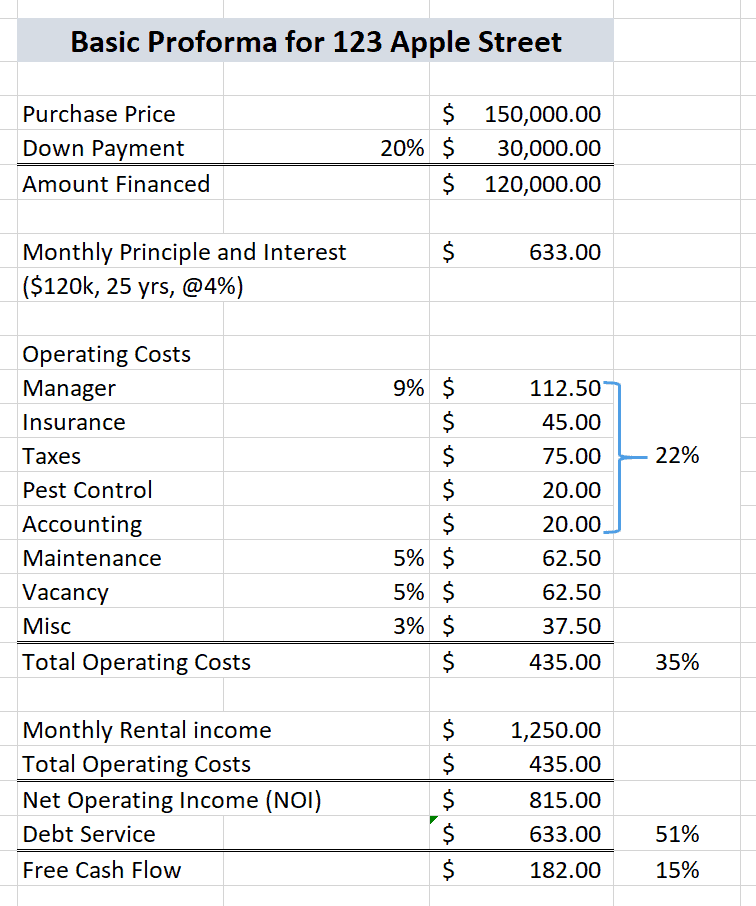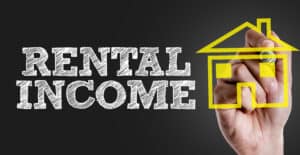The heart of making a decision on a property is building and analyzing a pro forma, which is a document used to quantitatively explain, outline, and check the assumptions of your financial plan. There are many ways that I have seen this done, but I am going to show you the way I typically use and explain why it seems to work for me.
To start, let’s talk about the three basic parts of a pro forma. First is the information about the unit you are potentially buying, or unit information. For example, the amount you spend on the unit, your down payment, and the monthly debt service to the bank (including both principal and interest).
Second is the operating cost. This should include all necessary expenses to operate the unit on a regular basis, including insurance, taxes, property manager, pest control, etc. After deducting operating costs, you’re left with Net Operating Income, as seen in this equation: rental income – operating expenses = Net Operating Income (NOI). NOI is an important number because it can determine the value of a property through a capitalization (cap) rate (more below).
Third is the cash produced after all expenses have been paid (all operating costs and debt service), which is called free cash flow. Free cash flow is the monthly money produced by the unit that can be left in the company.
Moving forward, I will discuss each section and make a few comments. I am sure we will take a deeper dive into each area in the future.

Section #1: Unit Information
What you end up paying for the unit is largely determined by the market value and the amount the bank is willing to loan (based on an appraisal). Typically, you will have to put cash down (20% is pretty common) and then finance the remaining amount. Overall, I try to shoot for a 20-year amortization period, but that can sometimes be difficult to get to cash flow well (based on interest rates, market conditions, etc.). At the time of writing this, commercial lending rates on rentals are about 4-5%, but those rates can change at any time. Fortunately, there are lots of loan calculators available as apps or for download on Microsoft Excel or Google Sheets, which can help you calculate loan amortizations. The one I use most often can be found here: Simple loan calculator and amortization table. To calculate a loan amortization, you will simply enter the term of the loan to be paid back, the amount you wish to borrow, and the interest rate of the loan.
Section #2: Operating Costs
Operating costs are the sum of all the regular expenses required to operate the unit. This includes taxes, insurance, pest control, management fees, POA/HOA dues, lawn care (if you provide that service), and any utility you may pay on behalf of the unit. Essentially, just think of what bills may come in (except debt service) that you will need to pay to keep the rental unit in operation and those are your operating costs.
I mentioned above that gross rent – operating costs = NOI, or Net Operating Income. NOI is important because it reflects the amount of money you have left over for debt service and free cash flow. I tend to think about NOI as the way you would think about gross profit margin in a typical profit and loss statement. Often associated with NOI are cap rates. A cap rate is a ratio of NOI divided by purchase price (or market value). Note that different people will include or exclude some expenses as they build their operating costs. Frequently, I see maintenance and vacancy budget setbacks omitted because they are not actual monthly expenses but merely a budgeted savings amount in anticipation of an expense. Here is a good article from Investopedia that can explain more about cap rates: Capitalization Rate Definition. Also, there are some great YouTube videos on these topics. Remember, NOI is calculated BEFORE you remove debt service.
When I build a pro forma, I try to include the non-cash expenses, as well as cash-operating costs. An example of non-cash expenses is vacancy and maintenance expenses. These expenses may not occur on a regular basis, but at some point, you will realize them. Therefore, it’s important to include them in your pro forma. For the sake of our discussion, we will call non-cash expenses “budget setbacks” because they are real expenses that you’ll require funds for at some point, maybe just not today. I try to keep the actual cash out-of-pocket expenses below 25% of my gross rent. If you include the budget setbacks, it will likely be closer to 33-35%. This is a good check and balance system to make sure you get enough rent out of a property. If the percentage is too high, the property may not be worth purchasing. This likely means the rentals in the area are below the current valuation (or asking price) of the property.
Section #3: Free Cash Flow (and Debt Service)
Debt service is another key point of evaluation when making a purchase. After placing 20% down, debt service should not be more than about 60% of your gross rents. I actually try to run about 55% or lower. So, for example, if you receive $1,250 per month in rent, the most you would want debt service to be is about $750. In our sample pro forma, debt service is 51%. That is a strong number! If the debt service runs at a smaller percentage than that, you will have more free cash flow. If it runs at a larger percentage, you will have less free cash flow. Keeping the debt service at 60% or less protects you if interest rates go up or if you have unforeseen expenses. Debt service is also a good indicator as to whether or not the property is a good deal. Typically, debt service is one of the first litmus tests I run a property against. It tends to be an easy thing to calculate in my head while I am talking to someone about the property.
Free cash flow is what is left after all expenses are subtracted out. Once you calculate your NOI and subtract your debt service amount, you are left with free cash flow.
As the market changes, free cash flow can fluctuate. Suppose rent rates are increasing but property values are static, here you will see more free cash flow. Recently, free cash flow has been decreasing because rent rates have remained somewhat static while property values and construction costs have increased. Basically, this means it costs more to buy a property and at the same time, you aren’t receiving more rent to cover the more expensive units. Therefore, your margin (free cash flow) shrinks.
At different times in the market cycle, I have had different expectations as to what free cash flow I wanted from a unit, which I would buy with a 20% cash down payment. Several years ago, I passed on some deals that yielded $200 per month in free cash flow because I could get $275 elsewhere. I didn’t want to give up my hard-fought capital to get only $200 per month! Lately, however, $200 per month is a much more realistic expectation for free cash flow. I think it’s the result of more competition that has driven the values of investment property higher.
Summing this all up:
The bank will want to see your pro forma once you get it done and request a loan. The bank will use the information on the pro forma to evaluate whether or not the property is a good deal, which you should be evaluating too. I typically use Microsoft Excel to build a pro forma, and then I use the “snipping tool” to cut and paste it into an email to my bank. I tend to stay away from sharing a live, active spreadsheet with my banker. Once I’ve emailed the pro forma to my banker, we often talk through the details of the document to make sure we are on the same page. This way, he can ask questions and get a good feel for what I’m doing before he represents me in a loan committee meeting. The more your banker knows, the better off you are when he/she has to answer questions from other loan committee members.
While there are many ways to build a pro forma, the way I’ve outlined here seems to be pretty simple and allows me to analyze the pro forma’s different parts in a predictable method. This technique also allows me to easily see the percentage breakdowns that matter most to me.
Here are a few takeaways I would leave you with:
- Build a good pro forma. Don’t get in a rush and enter bad information. Make sure all operating costs are included!
- Check what percentage your debt service will be against gross rents. Remember, below 60% is where you want to be.
- Make sure your real cash operating expenses are about 25% or less.
- Confirm you have a good free cash flow number ($200ish).
In a nutshell, this is how I build and evaluate a deal. I wish you all the best in your own pro forma endeavors!

